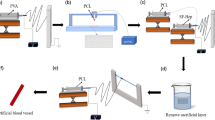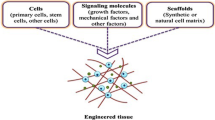Abstract
The ability to create three-dimensional (3D) cell-incorporated constructs for tissue engineering has progressed tremendously. One of the major challenges that limit the clinical applications of tissue engineering is the inability to form sufficient vascularization of capillary vessels in the 3D constructs. The lack of a functional capillary network for supplying nutrients and oxygen leads to poor cell viability. This paper presents the near-field electrospinning (ES) technique to fabricate a branched microfiber structure that mimics the morphology of capillaries. Polycaprolactone solution was electrospun onto a sloped collector that resulted in morphological and geometric variation of the fibers. With proper control over the solution viscosity and the electrospinning voltage, a single fiber was scattered into a branched fiber network and then converged back to a single fiber on the collector. The obtained fibers have a diameter of less than 100 microns at the two ends with coiled and branched fibers of less than 10 microns that mimics the arteriole-capillary-venule structure. The formation of such a structure in the near-field ES strongly depends on the solution viscosity. Low viscosity solutions form beads and discontinuous lines thus cannot be used to achieve the desired structure. The branching of PCL fiber occurs due to an electrohydrodynamic instability. The transition from the straight large fiber to smaller coiled/branched fibers is not instantaneous and stretches over a horizontal region of 1.5 cm. The current work shows the feasibility of electrospinning the stem-branch-stem fibrous structure by adopting a valley-shaped collector with potentials for tissue engineering applications.










Similar content being viewed by others
References
Ashima R, Haleem A, Bahl S, Javaid M, Mahla SK, Singh S (2021) Automation and manufacturing of smart materials in additive manufacturing technologies using internet of things towards the adoption of industry 4.0. Mater Today 45:5081–5088. https://doi.org/10.1016/j.matpr.2021.01.583
Britanica. Capillary. https://www.britannica.com/science/capillary
Beachley V, Wen X (2009) Effect of electrospinning parameters on the nanofiber diameter and length. Mater Sci Eng, C 29(3):663–668. https://doi.org/10.1016/j.msec.2008.10.037
Cengiz F, Dao TA, Jirsak O (2010) Influence of solution properties on the roller electrospinning of poly (vinyl alcohol). Polym Eng Sci 50(5):936–943. https://doi.org/10.1002/pen.21599
Chang WG, Niklason LE (2017) A short discourse on vascular tissue engineering. NPJ Regenerative Med 2(1):1–8. https://doi.org/10.1038/s41536-017-0011-6
Drew C, Wang X, Samuelson LA, Kumar J (2003) The effect of viscosity and filler on electrospun fiber morphology. J Macromol Sci Part A 40(12):1415–1422. https://doi.org/10.1081/MA-120025320
Fatima S, Haleem A, Bahl S, Javaid M, Mahla SK, Singh S (2021) Exploring the significant applications of internet of things (IoT) with 3D printing using advanced materials in medical field. Materials Today https://doi.org/10.1016/j.matpr.2021.01.305
Fong H, Chun I, Reneker DH (1999) Beaded nanofibers formed during electrospinning. Polymer 40(16):4585–4592. https://doi.org/10.1016/S0032-3861(99)00068-3
Fridrikh SV, Jian HY, Brenner MP, Rutledge GC (2003) Controlling the fiber diameter during electrospinning. Phys Rev Lett 90(14):144502. https://doi.org/10.1103/PhysRevLett.90.144502
Graessley WW (1967) Viscosity of entangling polydisperse polymers. J Chem Phys 47(6):1942–1953. https://doi.org/10.1063/1.1712222
Haider A, Haider S, Kang I-K (2018) A comprehensive review summarizing the effect of electrospinning parameters and potential applications of nanofibers in biomedical and biotechnology. Arab J Chem 11(8):1165–1188. https://doi.org/10.1016/j.arabjc.2015.11.015
Haleem A, Javaid M (2019a) Polyether ether ketone (PEEK) and its 3D printed implants applications in medical field: an overview. Clinical Epidemiology and Global Health 7(4):571–577. https://doi.org/10.1016/j.cegh.2019.01.003
Haleem A, Javaid M (2019b) Polyether ether ketone (PEEK) and its manufacturing of customised 3D printed dentistry parts using additive manufacturing. Clin Epidemiol Global Health 7(4):654–660. https://doi.org/10.1016/j.cegh.2019.03.001
Haleem A, Javaid M (2020) 3D printed medical parts with different materials using additive manufacturing. Clin Epidemiol Global Health 8(1):215–223. https://doi.org/10.1016/j.cegh.2019.08.002
Haleem A, Javaid M, Khan RH, Suman R (2020) 3D printing applications in bone tissue engineering. J Clin Orthopaedics Trauma 11:118–124. https://doi.org/10.1016/j.jcot.2019.12.002
Haq MIU, Khuroo S, Raina A, Khajuria S, Javaid M, Haq MFU, Haleem A. (2020). 3D printing for development of medical equipment amidst coronavirus (COVID-19) pandemic—review and advancements. Research on Biomedical Engineering, 1-11. https://doi.org/10.1007/s42600-020-00098-0
Huang Y, Bu N, Duan Y, Pan Y, Liu H, Yin Z, Xiong Y. (2013). Electrohydrodynamic direct-writing. Nanoscale, 5(24):12007-12017. https://doi.org/10.1039/C3NR04329K
Javaid M, Haleem A (2018a) Additive manufacturing applications in medical cases: a literature based review. Alexandria J Med 54(4):411–422. https://doi.org/10.1016/j.ajme.2017.09.003
Javaid M, Haleem A (2018b) Additive manufacturing applications in orthopaedics: a review. J Clin Orthopaedics Trauma 9(3):202–206. https://doi.org/10.1016/j.jcot.2018.04.008
Javaid M, Haleem A (2019) Current status and applications of additive manufacturing in dentistry: a literature-based review. J Oral Biol Craniofacial Res 9(3):179–185. https://doi.org/10.1016/j.jobcr.2019.04.004
Javaid M, Haleem A (2020) 3D printed tissue and organ using additive manufacturing: an overview. Clin Epidemiol Global Health 8(2):586–594. https://doi.org/10.1016/j.cegh.2019.12.008
Laschke MW, Menger MD (2016) Prevascularization in tissue engineering: current concepts and future directions. Biotechnol Adv 34(2):112–121. https://doi.org/10.1016/j.biotechadv.2015.12.004
Levick JR. (2013). An introduction to cardiovascular physiology: Butterworth-Heinemann.
Li Z, Wang C. (2013a). Effects of working parameters on electrospinning. In One-dimensional nanostructures (pp. 15–28): Springer. https://doi.org/10.1007/978-3-642-36427-3_2
Li Z, Wang C (2013b) One-dimensional nanostructures: electrospinning technique and unique nanofibers: Springer-Verlag. Berlin Heidelberg. https://doi.org/10.1007/978-3-642-36427-3
Lovett M, Lee K, Edwards A, Kaplan DL (2009) Vascularization strategies for tissue engineering. Tissue Eng Part B Rev 15(3):353–370. https://doi.org/10.1089/ten.teb.2009.0085
Mandrycky C, Phong K, Zheng Y (2017) Tissue engineering toward organ-specific regeneration and disease modeling. MRS Commun 7(3):332. https://doi.org/10.1557/mrc.2017.58
Marga F, Jakab K, Khatiwala C, Shepherd B, Dorfman S, Hubbard B, Colbert S, Forgacs G. (2012). Toward engineering functional organ modules by additive manufacturing. Biofabrication, 4(2):022001.
Nayak R, Padhye R, Kyratzis IL, Truong YB, Arnold L (2013) Effect of viscosity and electrical conductivity on the morphology and fiber diameter in melt electrospinning of polypropylene. Text Res J 83(6):606–617. https://doi.org/10.1177/0040517512458347
Neumann T, Nicholson BS, Sanders JE (2003) Tissue engineering of perfused microvessels. Microvasc Res 66(1):59–67. https://doi.org/10.1016/S0026-2862(03)00040-2
Nezarati RM, Eifert MB, Cosgriff-Hernandez E (2013) Effects of humidity and solution viscosity on electrospun fiber morphology. Tissue Eng Part C Methods 19(10):810–819. https://doi.org/10.1089/ten.tec.2012.0671
NIH. Dichloromethane (2021) https://www.euro.who.int/__data/assets/pdf_file/0013/123061/AQG2ndEd_5_7Dichloromethane.pdf
Paula KY, Balaratnasingam C, Cringle SJ, McAllister IL, Provis J, Yu D-Y (2010) Microstructure and network organization of the microvasculature in the human macula. Invest Ophthalmol vis Sci 51(12):6735–6743. https://doi.org/10.1167/iovs.10-5415
Rustad KC, Sorkin M, Levi B, Longaker MT, Gurtner GC (2010) Strategies for organ level tissue engineering. Organogenesis 6(3):151–157. https://doi.org/10.4161/org.6.3.12139
Sharma D, Ross D, Wang G, Jia W, Kirkpatrick SJ, Zhao F (2019) Upgrading prevascularization in tissue engineering: a review of strategies for promoting highly organized microvascular network formation. Acta Biomater 95:112–130. https://doi.org/10.1016/j.actbio.2019.03.016
Shieh S-J, Vacanti JP (2005) State-of-the-art tissue engineering: from tissue engineering to organ building. Surgery 137(1):1–7. https://doi.org/10.1016/j.surg.2004.04.002
Shin Y, Hohman M, Brenner M, Rutledge G (2001) Experimental characterization of electrospinning: the electrically forced jet and instabilities. Polymer 42(25):09955–09967. https://doi.org/10.1016/S0032-3861(01)00540-7
Šimko M, Lukáš D (2016) Mathematical modeling of a whipping instability of an electrically charged liquid jet. Appl Math Model 40(21–22):9565–9583. https://doi.org/10.1016/j.apm.2016.06.018
Sukmana I (2012) Microvascular guidance: a challenge to support the development of vascularised tissue engineering construct. Sci World J 2012:201352. https://doi.org/10.1100/2012/201352
Taylor AE, Moore TM (1999) Capillary fluid exchange. Adv Physiol Educ 277(6):S203
Teo WE, Ramakrishna S (2006) A review on electrospinning design and nanofibre assemblies. Nanotechnology 17(14):R89. https://doi.org/10.1088/0957-4484/17/14/R01
Tien J (2011) Tissue engineering of the microvasculature. Compr Physiol 9(3):1155–1212. https://doi.org/10.1002/cphy.c180037
Tuma RF, Durán WN, Ley K. (2011). Microcirculation (Vol. 4): Academic Press.
Vajda J, Milojević M, Maver U, Vihar B (2021) Microvascular tissue engineering—a review. Biomedicines 9(6):589. https://doi.org/10.3390/biomedicines9060589
Vyas C, Pereira R, Huang B, Liu F, Wang W, Bartolo P (2017) Engineering the vasculature with additive manufacturing. Curr Opin Biomed Eng 2:1–13. https://doi.org/10.1016/j.cobme.2017.05.008
Wu P, Ringeisen B (2010) Development of human umbilical vein endothelial cell (HUVEC) and human umbilical vein smooth muscle cell (HUVSMC) branch/stem structures on hydrogel layers via biological laser printing (BioLP). Biofabrication 2(1):014111. https://doi.org/10.1088/1758-5082/2/1/014111
Yarin A, Kataphinan W, Reneker DH (2005) Branching in electrospinning of nanofibers. J Appl Phys 98(6):064501. https://doi.org/10.1063/1.2060928
Zadpoor AA, Malda J. (2017). Additive manufacturing of biomaterials, tissues, and organs.Ann Biomed Eng volume 45:1–11 (2017). https://doi.org/10.1007/s10439-016-1719-y
Author information
Authors and Affiliations
Corresponding author
Ethics declarations
Conflict of interest
All authors declare that they have no conflict of interest.
Ethical approval
This article does not contain any studies with human participants or animals performed by any of the authors.
Additional information
Publisher's Note
Springer Nature remains neutral with regard to jurisdictional claims in published maps and institutional affiliations.
Rights and permissions
About this article
Cite this article
Qavi, I., Tan, G.Z. Near-field electrospinning polycaprolactone microfibers to mimic arteriole-capillary–venule structure. Prog Biomater 10, 223–233 (2021). https://doi.org/10.1007/s40204-021-00165-4
Received:
Accepted:
Published:
Issue Date:
DOI: https://doi.org/10.1007/s40204-021-00165-4




